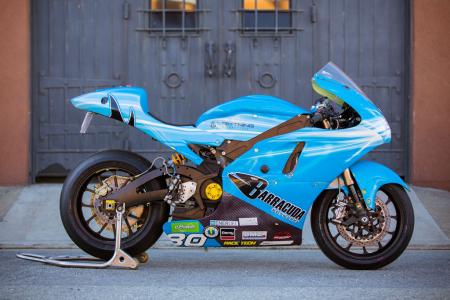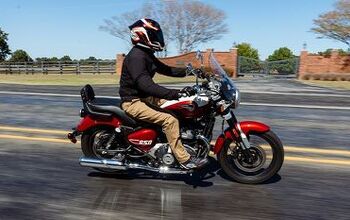2012 Lightning Motorcycles Exclusive First Ride - Video - Motorcycle.com
Using the words “Game Changer” in a motorcycle review is about as cliche as it gets. And almost without fail, the motorcycle in question isn’t worthy of the distinction. However, I’m confident when I say Richard Hatfield, CEO and founder of Lightning Motorcycles, has produced a sportbike sure to change the minds of anyone doubting electric motorcycle performance. The Lightning, without a doubt, is the fastest motorcycle I’ve ever ridden – gas or electric.
AMA veteran Michael Barnes has been piloting the Lightning racebike in TTXGP competition, most recently winning the combined FIM e-Power/TTXGP round at Laguna Seca by a big margin. At the season opener at Infineon Raceway, we caught up with Hatfield, where he revealed the reason behind the last six years of blood, sweat and tears. Lightning, like Zero and Brammo, is going to market with a production streetbike.
From the Track to the Street. Literally.
Lightning's forthcoming consumer-level electric motorcycle is based on its racebike, and yours truly is the first to ride it. Well, mostly. I would actually be riding Michael Barnes’ racebike, exactly how it rolled onto the grid at Laguna Seca. Unlike most petrol race bikes, which are highly modified production bikes, underneath the Lightning’s race fairings, the internals will be exactly the same as the production bike.
In more relatable terms, imagine being able to purchase Josh Hayes’ championship-winning Yamaha YZF-R1 AMA Superbike and riding it everyday because it’s street legal. That’s the kind of package Lightning is offering.
And when I say it’s based on the racebike, I mean it. Hatfield assures us the very same internals “Barney” races with will be inside each production bike, maybe even better. Each Lightning is built to order from top to bottom, meaning the air/oil-cooled 12kWh battery currently being raced with will come standard, and a 14kWh unit will be available as an option. For those who can’t get enough torque, testing is currently being conducted on a 22kWh battery!
Each Lightning is a monocoque design, using the battery and motor assembly as the main stressed members of the chassis, similar to the Ducati 1199 Panigale. “Because wherever you can make one part serve more than one function, you save weight,” Hatfield says. The liquid-cooled, IPM motor, according to Hatfield, is the same unit GM uses in its Tahoe SUV hybrid. “If it can push a 6000-plus pound truck, think of its performance in a 500-pound motorcycle.” Hatfield says the motor units have been certified to last 900,000 miles.
The Lightning features programmable regenerative braking, a feature which partially recharges the batteries each time the throttle is closed. It also acts to replicate the engine braking effect seen on internal combustion engine (ICE) vehicles. The programmable bit means the end user can choose whether they want more or less “regen.” Adding more produces a higher engine braking effect, while less does the opposite.
Of course, the ever-present issue with electric transportation is range and charge time. Both subjects are difficult to address for manufacturers, as each depends on the user and their riding habits. However, Hatfield claims, under moderate highway riding averaging 70 mph, a 100-plus-mile range is possible on the Lightning. On the other hand, during the Isle of Man TT race, the batteries were depleted at the end of the 38-mile lap.
Depending on the station, recharge time for the batteries varies widely. Level 2 charging stations and the J1772 connector it uses are becoming standardized as the electric/hybrid automotive industry matures. With a Level 2 charger, Hatfield claims recharge times as little as two hours for the LiPo (Lithium Ion Polymer) batteries. Expect eight hours with a standard 110v wall outlet.
Another option is to harness the power of the sun. At the Laguna Seca round of the combined FIM e-Power/TTXGP series, Lightning debuted solar panels used to charge the batteries of two racebikes, including this one. Hatfield is in talks with Trina Solar, one of the world’s largest photovoltaic companies, to provide solar panels to customers for a yet-undetermined fee. They can install the panels in their homes and charge their motorcycle without burning any fossil fuels. Charge time is dependent on the number of panels purchased.
The rest of the motorcycle features fairly conventional components. Lightning used the Suzuki GSX-R1000 as its benchmark when determining suspension geometry because, as Hatfield says, “It works, doesn’t it?” Fork stanchions are based on the Gixxer’s with Racetech internals, while an Ohlins shock mates frame and swingarm without linkages. Forged magnesium wheels are used at both ends, while top-shelf Brembo monobloc brakes provide stopping power.
I should stress again these are simply the components used on the racebike. All parts are customizable according to the customer’s specifications, desires, and wallet.
The Ride
First some bad news: due to circumstances beyond our control (like a cancelled flight and lost gear bag), seat time aboard the Lightning was extremely short. However, it was all the time I needed to realize this was, by far, the fastest motorcycle I’ve ever ridden. Consider for a moment this same motorcycle achieved 218 mph at the Bonneville Salt Flats - a venue with an inherently slippery surface limiting the amount of power you can successfully put to the ground. It then won a road race shortly after.
My immediate impression of the Lightning’s ergos is that the seat-to-bar ratio is rather long, as all the batteries take up space where a conventional fuel tank would sit. This seating arrangement is biased towards placing much more of the rider’s weight over their wrists than other sportbikes I’ve ridden. I was surprised to discover Barnes’ preferred footpeg height and positioning wasn’t nearly as high or rearset as other racing motorcycles I’ve sampled. It feels very much like any other production sportbike available today. For those who prefer their pegs high, they are also adjustable.
Turn the Lightning on and the gauge cluster runs through a series of checks. Once it finishes the bike is powered up and ready to ride, but it doesn’t make a sound. I twist the electronic throttle gently, as leaving from a stop is a different sensation than a gas bike. Without a clutch to modulate power (it’s a single speed), the first few degrees of throttle turn deliver gentle power to start rolling.
The Lightning can cruise at 50 mph all day long as smooth as a scooter. There’s no surging or lunging, and the lack of engine noise means all I’m hearing is a whirl from the electric motor and the wind blowing past. Power is delivered in a progressive, linear fashion, and when I decided to open her up, the Lightning unleashed a fury unlike anything I’ve ever experienced.
It starts with the electric motor making a spooling sound as if it’s readying for warp drive, then, as quickly as I could register the sound, the Lightning simply blasts down the road. The acceleration is mind-boggling and it was all I could do just to hang on. Speed continued to climb, objects in my peripheral were a blur, and I resorted to tunnel vision, looking as high as I could to process the road ahead.
The front wheel does come up – after all, Hatfield says the bike has 2.5 times the torque of a GSX-R1000 – but thanks to the linear power delivery it does so predictably, allowing me time to place my weight over the bars and dab the rear brake to bring it back to Earth. Meanwhile the motor didn’t show any signs of reaching its limit – I let up before it did.
Anyone familiar with modulating throttle on a gas motorcycle will be able to operate the Lightning. In fact, the learning curve is easier as there’s no clutch or shifter to worry about. The difference is engine noise is replaced with the sound of an electric motor spinning.
Interestingly, the regenerative effect was more pronounced at slower speeds. Shutting the throttle at higher speeds resulted in what felt like a free-wheeling sensation. Hatfield suspects the weight of the motorcycle combined with the higher speed made it feel as though the regen wasn’t working and was the cause of the two-stroke-like feeling.
Get the Flash Player to see this player. callPlayer(xml_url,"JJfZzlRQXa0","galleryPlayer_2","500","281","1"); |
| This video shows in graphic detail the brutal acceleration offered by the Lightning. The camera bike is being piloted by AMA Pro Superbike rider Jake Holden aboard a BMW S1000RR. Though Holden has superior corner entry skills and could have passed, watch the corner exits as Ted Rich aboard the Lightning simply leaves Holden in his dust. Incredible. |
The rest of the motorcycle is equally impressive as well. As you’d expect, with forged magnesium wheels the Lightning flicks to and fro better than any 500-pound motorcycle has a right to. Being on used Dunlop slicks without warmers on a canyon road, wearing borrowed gear on a motorcycle scheduled to be raced at the FIM e-Power race at LeMans, France, I knew crashing wasn’t an option and rode accordingly.
That said, the Lightning’s handling is impressive. The suspension was understandably stiff, being a racebike and all, but it tracks through turns with ease. Line selection is easily adjusted, even mid-turn. Reaching extreme lean angles wasn’t happening today, but considering what Barnes is able to do on it, I’m sure it has a scalpel-like ablility to carve a turn. Stopping power from the monobloc Brembo brakes is equally impressive, but that shouldn’t be a surprise to anyone.
The Future Is Here
Unfortunately, the ride was over too soon. On this public road I never built the courage to open it full throttle, but what I did experience was enough to make me a believer. From a performance standpoint, e-bikes like the Lightning are already on par with its gas counterpart. Never before have I experienced arm-pulling torque like this.
Personally, I don’t give much thought to the environmental benefits of electric vehicles simply because the emissions still come from somewhere. I judge a motorcycle, gas or electric, on its performance. But this is where Lightning rightly deserves to be called a game changer.
Yes, the motorcycle is amazingly impressive, but Richard Hatfield is quietly building the infrastructure, with help from companies like Trina Solar, to continue enjoying his motorcycles while leaving as little a carbon footprint as possible. That’s big.
More unbelievable is the fact that anyone can purchase this motorcycle right now. However, performance like this comes at a price. Starting at $38,000, the Lightning isn’t cheap. But if you can afford one, you’ll be in a very exclusive club.
Go to the Lightning website to order. Hatfield claims you’ll have your bike in 60-90 days. If the opportunity comes up again to put the Lightning through its paces, especially on a track, rest assured it will be done. For now, trust me when I say the Lightning is unlike anything I’ve ever ridden.
Related Reading
2012 FIM e-Power/TTXGP Laguna Seca Race Report
Racing Electric Motorcycles - Video
2012 Brammo Empulse and Empulse R First Look
2012 Zero DS Review - Video
Lightning Motorcycles Signs Deal with Lithium-Ion Battery Maker
More by Troy Siahaan





































Comments
Join the conversation